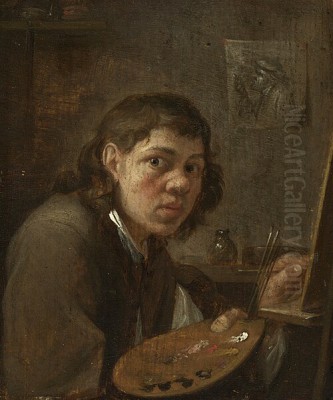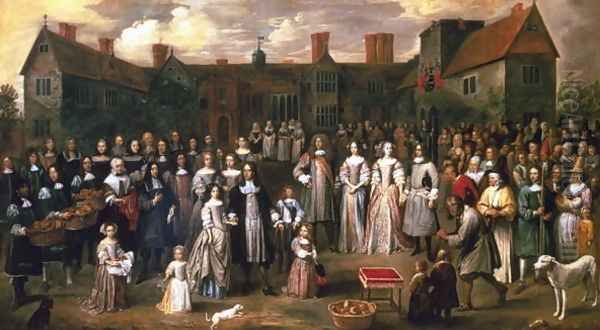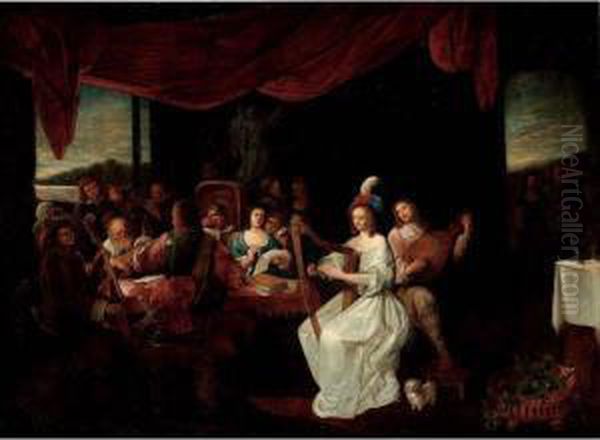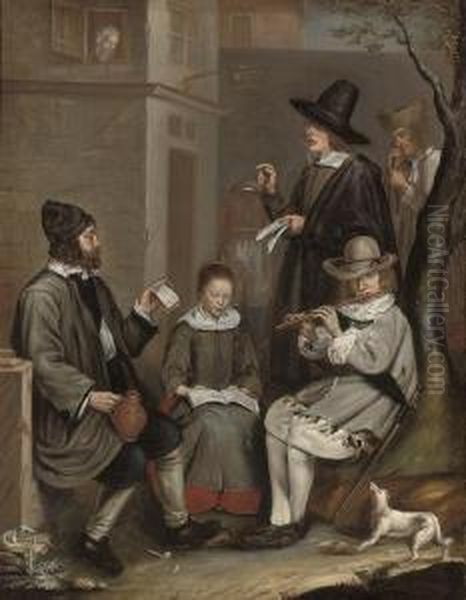Introduction: A Flemish Master of Genre

Gillis van Tilborgh, also known as Gillis van Tilborch or Tilburg, stands as a significant figure in the rich tapestry of 17th-century Flemish Baroque painting. Born around 1625 in Brussels and active until his death around 1678, Tilborgh dedicated his artistic career primarily to the depiction of everyday life, becoming a master of the genre scene. Operating predominantly within his native Brussels, he captured the spirit of his time, offering vivid glimpses into the social customs, gatherings, and environments of the Southern Netherlands during a period of complex political and cultural transition. His work, belonging firmly to the Flemish School, is characterized by its lively compositions, keen observation, and often vibrant use of color, securing his place among the notable painters of his generation.
Tilborgh's artistic output provides invaluable visual documentation of 17th-century Flemish society. From bustling tavern interiors and rustic peasant gatherings to more composed group portraits and allegorical scenes, his paintings reflect the diverse social strata and activities of the era. He navigated the artistic landscape following the towering achievements of masters like Peter Paul Rubens and Anthony van Dyck, carving out his niche in the popular and evolving field of genre painting, a domain significantly shaped by his likely teacher, David Teniers the Younger.
Early Life and Artistic Formation in Brussels
Details surrounding Gillis van Tilborgh's earliest years and initial training remain somewhat scarce, a common challenge when researching artists from this period. It is widely accepted that he was born in Brussels, a major artistic and administrative center in the Spanish Netherlands, around the year 1625. Brussels, despite the political and economic shifts following the Dutch Revolt, maintained a vibrant cultural life and a strong tradition of craftsmanship, including painting and tapestry weaving. It was within this environment that Tilborgh began his artistic journey.

The most significant formative influence on Tilborgh was undoubtedly David Teniers the Younger (1610-1690), the preeminent Flemish genre painter of the mid-17th century. While definitive documentation of a formal apprenticeship is lacking, the stylistic and thematic similarities between their works are so pronounced that art historians widely accept that Tilborgh studied under Teniers or, at the very least, worked closely within his circle and absorbed his methods. Teniers himself was known for his prolific output, his diverse subject matter ranging from peasant kermesses to alchemist laboratories and sophisticated gallery paintings, and his influential position as court painter to Archduke Leopold Wilhelm of Austria, the governor of the Spanish Netherlands.
Tilborgh likely absorbed Teniers' techniques for rendering textures, his approach to composing multi-figure scenes, and his characteristic palette, often featuring earthy tones punctuated by brighter accents. He formally entered the Brussels Guild of Saint Luke, the city's official organization for painters and other artisans, as a master in 1654. This membership was crucial, granting him the right to establish his own workshop, take on pupils, and sell his works publicly within the city. This marked the official commencement of his independent career.
Artistic Style: Observation, Color, and Light
Gillis van Tilborgh's style is firmly rooted in the Flemish Baroque tradition, particularly as it manifested in genre painting. His work is characterized by a careful observation of human behavior and social interaction, rendered with a lively and often detailed brushwork. He possessed a strong sense of narrative, effectively staging scenes that tell a story or capture a specific moment in time, whether it be a boisterous celebration or a quiet domestic task.
Color plays a significant role in his compositions. While often employing the earthy browns, ochres, and grays typical of Teniers and other Flemish genre painters, Tilborgh frequently enlivened his scenes with bolder splashes of primary colors – reds, blues, and yellows – particularly in the clothing of his figures. This use of color contributes to the vibrancy and visual appeal of his work, drawing the viewer's eye and highlighting key elements within the composition. His handling of paint could range from relatively smooth passages to more textured, visible brushstrokes, depending on the subject and desired effect.
The treatment of light and shadow, or chiaroscuro, is another key element. Following the example of Teniers, Tilborgh skillfully used light to model forms, create atmosphere, and direct attention within the scene. Interior scenes often feature a light source coming from a window or doorway, illuminating the central figures while leaving corners in shadow, adding depth and a sense of intimacy or enclosure. Outdoor scenes, conversely, often display a brighter, more diffused light characteristic of the Low Countries' climate. His ability to render different textures – rough wood, coarse fabrics, gleaming metal, or translucent glass – adds a tactile quality to his paintings.
The Influence of David Teniers the Younger

The artistic debt Gillis van Tilborgh owed to David Teniers the Younger cannot be overstated. Teniers' influence is palpable across much of Tilborgh's oeuvre, evident in subject matter, compositional strategies, figure types, and overall handling. Tilborgh adopted many of Teniers' favorite themes, including peasant interiors, tavern scenes, village festivals (kermesses), and guardroom scenes (kortegaardjes). He often populated his canvases with similar character types: sturdy peasants, carousing soldiers, and busy housewives.
Tilborgh learned from Teniers how to organize complex scenes with numerous figures, arranging them in naturalistic groupings that create a sense of depth and lively interaction. The use of diagonal lines in the composition, often leading the eye from the foreground into the background space, is a common feature derived from Teniers. Furthermore, Tilborgh's meticulous attention to still-life details within his genre scenes – jugs, barrels, cooking utensils, discarded objects – echoes Teniers' own skill in rendering inanimate objects with convincing realism.
However, while clearly a follower, Tilborgh was not merely an imitator. His figures sometimes possess a slightly more robust or even coarser quality than Teniers' later, more refined peasant types. His color palette, while related, can occasionally be brighter or exhibit different harmonies. While Teniers achieved enormous success and international fame, Tilborgh operated on a slightly less prominent, though still successful, level, primarily serving the Brussels market. He adapted the Teniers model to his own sensibilities and clientele, creating a distinct, recognizable body of work within the broader tradition. Other artists strongly influenced by Teniers include Joos van Craesbeeck and David Ryckaert III, forming a significant school of genre painting in Flanders.
Themes and Subject Matter: A Mirror to Society
Gillis van Tilborgh's paintings offer a fascinating window into the social fabric of the 17th-century Southern Netherlands. His choice of subject matter reflects the tastes of the contemporary art market, which showed a strong appetite for scenes of everyday life, alongside the more traditional religious and historical subjects favored by earlier generations and patrons like the Church.
Tavern and Peasant Scenes

A substantial portion of Tilborgh's output consists of scenes set in rustic taverns or depicting peasant life. These paintings often show villagers drinking, smoking, playing cards, making music, or engaging in lively, sometimes boisterous, interactions. Works like Repas à une auberge (Meal at an Inn) or Drinking and Smoking Outside a Hut exemplify this category. These scenes continued a tradition popularized earlier by artists like Adriaen Brouwer (who worked in both Flanders and the Dutch Republic) and carried to immense popularity by Teniers. While sometimes humorous or anecdotal, these depictions could also carry moralizing undertones about moderation or the follies of indulgence, though often the primary aim seems to have been entertainment and the skillful depiction of character and atmosphere.
Village Festivals and Gatherings
Larger outdoor scenes depicting village festivals (kermesses) or specific communal events were also part of Tilborgh's repertoire. These allowed him to showcase his ability to handle large numbers of figures and create panoramic views of rural life. A Wedding Celebration captures the communal joy and rituals associated with marriage in a village setting. Perhaps his most famous work in this vein is the Annual competition of the Archers' Guild. This painting vividly portrays a significant civic event in Brussels, showing members of the archers' guild competing near the Wollendriestoren tower, with numerous spectators from various social classes observing the proceedings. It serves as both a genre scene and a valuable topographical record of the city at the time.
Elegant Companies and Interior Scenes
While often associated with lower-class subjects, Tilborgh also depicted more refined social gatherings, sometimes referred to as "elegant companies" or "merry companies." These scenes might show well-dressed burghers or aristocrats engaged in conversation, playing music, or dining in comfortable interior settings. Music-Making Company is an example where the focus shifts towards a more cultured pastime, reflecting the musical interests of the urban bourgeoisie. These works align with a broader European trend in genre painting, seen also in the Dutch Republic with artists like Gerard ter Borch or Jacob Ochtervelt, though Tilborgh retains a distinctly Flemish flavor.
Group Portraits and Allegories
Tilborgh was also adept at group portraiture, often embedding his sitters within a genre-like setting. He is known to have painted family portraits where the members are shown in their home environment, perhaps engaged in activities that signify their status or interests. A notable example is his depiction of the Tichborne Dole, an English aristocratic family distributing charity, painted during a possible visit to England or for English patrons. He also tackled allegorical subjects, such as The greedy couple of old men weighing their possessions, which uses a genre setting to convey a moral message about avarice, a theme with roots in earlier Netherlandish art, for instance, in the work of Quentin Matsys or Marinus van Reymerswaele.
Gallery Paintings (Kunstkamers)
Following the trend set by his master, David Teniers the Younger, and earlier artists like Jan Brueghel the Elder and Frans Francken the Younger, Tilborgh also painted "gallery paintings" or kunstkamers. These intricate works depict actual or imaginary art collections, often showcasing the owner's wealth, taste, and erudition. They typically feature rooms filled with paintings, sculptures, scientific instruments, and natural curiosities. Tilborgh sometimes included portraits of the collectors or artists (including self-portraits) within these settings, blending portraiture with still life and architectural painting. These works are particularly valuable for art historians as they document collecting practices and sometimes depict identifiable works of art from the period.
Notable Works: A Closer Look
Several key works exemplify Gillis van Tilborgh's style and thematic concerns:
Annual competition of the Archers' Guild (Brussels City Museum): This large and detailed canvas is arguably one of his most important works. It captures a specific annual event in Brussels with topographical accuracy, showing the cityscape and a diverse crowd. The lively depiction of the archers, the spectators, and the surrounding architecture showcases his skill in handling complex compositions and provides a vibrant snapshot of civic life.
The Tichborne Dole (Collection unknown, possibly UK): This painting is significant as it depicts an English custom and family, suggesting Tilborgh either travelled to England or had connections with English patrons. It combines group portraiture with a narrative scene of charitable distribution, demonstrating his versatility.
Het Paleis van Nassau te Brussel (The Palace of Nassau in Brussels) (1658; various versions/collections exist, e.g., Musée des Beaux-Arts de Dijon): This work is notable for being a documented collaboration with the architectural painter Willem van Schoor. Tilborgh likely painted the figures within the architectural setting provided by van Schoor. It depicts the courtyard of a prominent Brussels palace, again blending genre elements with topographical interest and showcasing the practice of artistic collaboration common in the period. Other collaborators in Antwerp included landscape specialists like Jacques d'Arthois, who might provide backgrounds for figure painters.
A Wedding Celebration: Representative of his village festival scenes, this work captures the energy and communal aspect of rural life. The composition typically involves numerous figures engaged in various activities – dancing, eating, drinking, conversing – creating a dynamic and engaging spectacle.
The greedy couple of old men weighing their possessions (Musée des Beaux-Arts, Metz): This painting highlights Tilborgh's engagement with moralizing allegory within a genre framework. The detailed rendering of the couple, their coins, and their intense focus on wealth serves as a commentary on avarice, a popular theme in Netherlandish art.
Scene in a School Room: Tilborgh painted several versions of schoolroom scenes. These works reflect contemporary interest in education and childhood, depicting interactions between teachers and pupils in often humble settings. They offer insights into pedagogical practices and the social environment of learning in the 17th century, a theme also explored by Dutch artists like Jan Steen.
The Brussels Milieu and Artistic Context
Gillis van Tilborgh's career unfolded primarily in Brussels, which held a distinct position within the Spanish Netherlands. While Antwerp had been the dominant artistic center in the 16th and early 17th centuries, Brussels remained important as the seat of the court of the governors-general. This court provided a significant source of patronage, although perhaps less lavishly than in previous eras. Tilborgh himself achieved a notable position later in his career, being appointed as the keeper or curator of the painting collection at the Tervuren castle, the country residence of the governor, in 1666. This role suggests he enjoyed a degree of official recognition and trust.
The Brussels Guild of Saint Luke, to which Tilborgh belonged, regulated the art market and maintained standards. The city supported a community of artists working in various genres. Besides genre painters like Tilborgh, there were landscape specialists such as Jacques d'Arthois and Lodewijk de Vadder, portraitists, and tapestry designers continuing Brussels' long-standing fame in that medium. The demand for art came not only from the court and nobility but also from the increasingly prosperous bourgeoisie – merchants, guild members, and professionals – who favored smaller-scale works, including genre scenes and portraits, suitable for domestic interiors.
Tilborgh's work, with its focus on local customs (like the archers' competition), social gatherings, and familiar environments, catered well to this local market. His paintings provided relatable reflections of the viewers' own world, albeit sometimes idealized or humorously exaggerated. He operated within a broader European context where genre painting was flourishing, not just in Flanders but notably in the neighboring Dutch Republic with masters like Rembrandt (in his earlier genre scenes), Jan Steen, Adriaen van Ostade, Gabriel Metsu, and Pieter de Hooch, each developing distinct regional styles and thematic specializations.
Collaboration and Workshop Practice
The documented collaboration between Gillis van Tilborgh and Willem van Schoor on The Palace of Nassau in Brussels highlights a common practice in 17th-century Netherlandish art. Specialization was prevalent, and it was not unusual for artists to collaborate, with one painting the figures and another the landscape, architecture, or still-life elements. David Teniers the Younger himself collaborated with artists like Jan Davidsz. de Heem (still life) and Jan Brueghel the Younger (landscape/flowers). While the collaboration with van Schoor is confirmed, it is likely Tilborgh may have engaged in other, undocumented collaborations throughout his career.
Like most successful masters of the period, Tilborgh would have maintained a workshop. This workshop would have included apprentices learning the trade and possibly assistants helping with preparatory work, background painting, or the production of replicas and variants of popular compositions. The degree of workshop participation in paintings attributed solely to Tilborgh is often difficult to determine precisely, but it was a standard aspect of artistic production aimed at meeting market demand efficiently. The consistency in style across many of his works, however, suggests a strong guiding hand from the master himself.
Later Career, Legacy, and Reception
Information about Tilborgh's later years is limited. His appointment as keeper of the Tervuren collection in 1666 marks a high point in his career, indicating respect for his expertise. He continued to paint actively through the 1660s and likely into the 1670s. The exact date of his death is uncertain but is generally placed around 1678, in Brussels.
Gillis van Tilborgh's legacy lies in his contribution to the rich tradition of Flemish genre painting. While perhaps overshadowed in historical accounts by the towering figures of Rubens, Van Dyck, or even his master Teniers, Tilborgh was a highly competent and productive artist who skillfully captured the nuances of everyday life in his time. His works are valuable not only for their artistic merit – their lively compositions, observational detail, and appealing color – but also as historical documents reflecting the social customs, environments, and even specific events of 17th-century Brussels.
His influence extended beyond Flanders. The popularity of Flemish genre painting, including works by Teniers and his followers like Tilborgh, had an impact on art in England and other parts of Europe. His paintings were collected during his lifetime and continued to be appreciated in the centuries that followed, appearing in significant collections and auctions. Today, his works are held by numerous major museums across the world, including the Louvre in Paris, the Prado in Madrid, the Hermitage Museum in St. Petersburg, the Rijksmuseum in Amsterdam, the Royal Museums of Fine Arts of Belgium in Brussels, and many regional museums, such as the Musée des Beaux-Arts in Metz.
Art historians regard Gillis van Tilborgh as a key representative of the second generation of Flemish genre painters who built upon the innovations of Brouwer and Teniers. He successfully adapted the established formulas to create works that appealed to the tastes of his time, demonstrating technical skill and a keen eye for the human condition in its everyday manifestations. He remains an important figure for understanding the breadth and vitality of painting in the Southern Netherlands during the Baroque era.
Conclusion: A Painter of His Time
Gillis van Tilborgh emerges from the historical record as a quintessential Flemish genre painter of the 17th century. Deeply influenced by his master David Teniers the Younger, he nonetheless developed a recognizable style characterized by lively observation, skillful composition, and a palette that balanced earthy tones with vibrant accents. His depictions of tavern brawls, village festivals, elegant gatherings, and specific civic events like the Brussels archers' competition provide an invaluable visual chronicle of life in the Spanish Netherlands.
Working primarily for the Brussels market, and achieving recognition through his guild membership and later court appointment, Tilborgh catered to the growing demand for scenes of everyday life. His paintings, found today in museums worldwide, continue to engage viewers with their narrative detail and atmospheric settings. While perhaps not an innovator on the scale of Rubens or Rembrandt, Gillis van Tilborgh was a master craftsman and a perceptive chronicler of his society, securing his enduring place within the history of Flemish Baroque art. His work stands as a testament to the enduring appeal of genre painting and its power to reflect the human experience across different social strata.